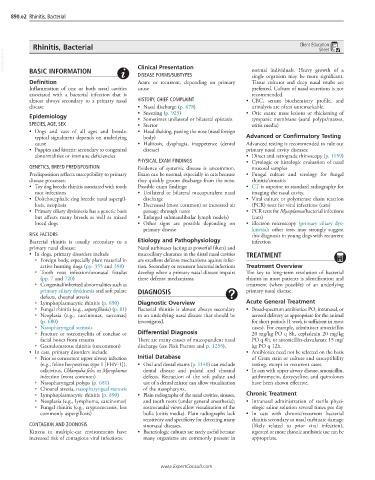Page 1772 - Cote clinical veterinary advisor dogs and cats 4th
P. 1772
890.e2 Rhinitis, Bacterial
Rhinitis, Bacterial Client Education
Sheet
VetBooks.ir Clinical Presentation
BASIC INFORMATION
DISEASE FORMS/SUBTYPES normal individuals. Heavy growth of a
single organism may be more significant.
Definition Acute or recurrent, depending on primary Tissue cultures and deep nasal swabs are
Inflammation of one or both nasal cavities cause preferred. Culture of nasal secretions is not
associated with a bacterial infection that is recommended.
almost always secondary to a primary nasal HISTORY, CHIEF COMPLAINT • CBC, serum biochemistry profile, and
disease • Nasal discharge (p. 678) urinalysis are often unremarkable.
• Sneezing (p. 925) • Otic exam: mass lesions or thickening of
Epidemiology • Sometimes unilateral or bilateral epistaxis tympanic membrane (aural polyps/masses,
SPECIES, AGE, SEX • Stertor otitis media)
• Dogs and cats of all ages and breeds: • Head shaking, pawing the nose (nasal foreign
typical signalment depends on underlying body) Advanced or Confirmatory Testing
cause • Halitosis, dysphagia, inappetence (dental Advanced testing is recommended to rule out
• Puppies and kittens: secondary to congenital disease) primary nasal cavity diseases:
abnormalities or immune deficiencies • Direct and retrograde rhinoscopy (p. 1159)
PHYSICAL EXAM FINDINGS • Cytologic or histologic evaluation of nasal
GENETICS, BREED PREDISPOSITION Evidence of systemic disease is uncommon. mucosal samples
Predisposition reflects susceptibility to primary Exam can be normal, especially in cats because • Fungal culture and serology for fungal
disease processes: they quickly groom discharge from the nose. rhinitis/sinusitis
• Toy dog breeds: rhinitis associated with tooth Possible exam findings: • CT is superior to standard radiography for
root infections • Unilateral or bilateral mucopurulent nasal imaging the nasal cavity.
• Dolichocephalic dog breeds: nasal aspergil- discharge • Viral culture or polymerase chain reaction
losis, neoplasia • Decreased (most common) or increased air (PCR) tests for viral infections (cats)
• Primary ciliary dyskinesia has a genetic basis passage through nares • PCR tests for Mycoplasma/bacterial infections
but affects many breeds as well as mixed • Enlarged submandibular lymph node(s) (cats)
breed dogs • Other signs are possible depending on • Electron microscopy (primary ciliary dys-
primary disease kinesia); other tests may strongly suggest
RISK FACTORS this diagnosis in young dogs with recurrent
Bacterial rhinitis is usually secondary to a Etiology and Pathophysiology infection
primary nasal disease: Nasal turbinates (acting as powerful filters) and
• In dogs, primary disorders include mucociliary clearance in the distal nasal cavities TREATMENT
○ Foreign body, especially plant material in are excellent defense mechanisms against infec-
active hunting dogs (pp. 355 and 398) tion. Secondary or recurrent bacterial infections Treatment Overview
○ Tooth root infection/oronasal fistulas develop when a primary nasal disease impairs The key to long-term resolution of bacterial
(pp. 7 and 720) these defense mechanisms. rhinitis in most patients is identification and
○ Congenital/inherited abnormalities such as treatment (when possible) of an underlying
primary ciliary dyskinesia and soft palate DIAGNOSIS primary nasal disease.
defects, choanal atresia
○ Lymphoplasmacytic rhinitis (p. 890) Diagnostic Overview Acute General Treatment
○ Fungal rhinitis (e.g., aspergillosis) (p. 81) Bacterial rhinitis is almost always secondary • Broad-spectrum antibiotics: PO, intranasal, or
○ Neoplasia (e.g., carcinomas, sarcomas) to an underlying nasal disease that should be aerosol delivery as appropriate for the animal
(p. 680) investigated. for short periods (1 week is sufficient in most
○ Nasopharyngeal stenosis cases). For example, administer amoxicillin
○ Fracture or osteomyelitis of conchae or Differential Diagnosis 20 mg/kg PO q 8h, cephalexin 20 mg/kg
facial bones from trauma There are many causes of mucopurulent nasal PO q 8h, or amoxicillin-clavulanate 15 mg/
○ Granulomatous rhinitis (uncommon) discharge (see Risk Factors and p. 1255). kg PO q 12h.
• In cats, primary disorders include • Antibiotics need not be selected on the basis
○ Prior or concurrent upper airway infection Initial Database of Gram stain or culture and susceptibility
(e.g., feline herpesvirus type 1 [FHV-1]), • Oral and dental exams (p. 1140) can exclude testing, except in recurrent cases.
calicivirus, Chlamydia felis, or Mycoplasma dental disease and palatal and choanal • In cats with upper airway disease, amoxicillin,
infection (most common) defects. Retraction of the soft palate and azithromycin, doxycycline, and quinolones
○ Nasopharyngeal polyps (p. 681) use of a dental mirror can allow visualization have been shown effective.
○ Choanal atresia, nasopharyngeal stenosis of the nasopharynx.
○ Lymphoplasmacytic rhinitis (p. 890) • Plain radiographs of the nasal cavities, sinuses, Chronic Treatment
○ Neoplasia (e.g., lymphoma, carcinomas) and tooth roots (under general anesthesia); • Intranasal administration of sterile physi-
○ Fungal rhinitis (e.g., cryptococcosis, less rostrocaudal views allow visualization of the ologic saline solution several times per day
commonly aspergillosis) bulla (otitis media). Plain radiographs lack • In cats with chronic/recurrent bacterial
sensitivity and specificity for detecting many rhinitis secondary to nasal turbinate damage
CONTAGION AND ZOONOSIS sinonasal diseases. (likely related to prior viral infection),
Kittens in multiple-cat environments have • Bacteriologic cultures are rarely useful because repeated or more chronic antibiotic use can be
increased risk of contagious viral infections. many organisms are commonly present in appropriate.
www.ExpertConsult.com

